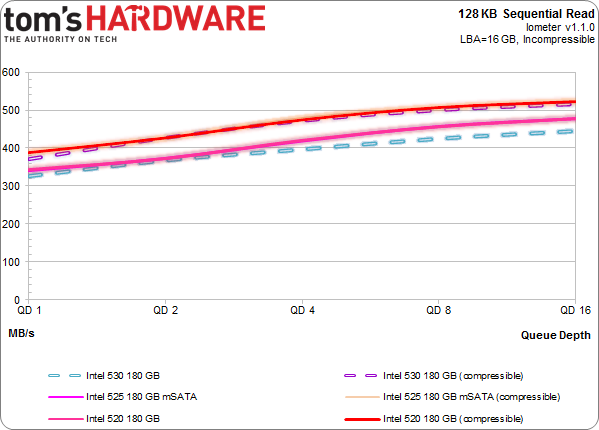Intel SSD 530 Review: A Revised Controller And 20 nm Flash
Intel recently lifted the veil on a replacement for its SSD 520, not surprisingly called the SSD 530. It partners new SandForce silicon with IMFT's 20 nm flash for better power consumption and a more modest price tag. Does the evolution pay off?
Results: 128 KB Sequential Performance
Fantastic sequential read and write performance is a trademark of modern SSDs. To measure it, we use incompressible data over a 16 GB LBA space, then test at queue depths from one to 16. We're reporting these numbers in binary (where 1 KB equals 1024) instead of decimal numbers (where 1 KB is 1000 bytes). When necessary, we're also limiting the scale of the chart to enhance readability.
128 KB Sequential Read
The SSD 530, 525, and 520 are very similar, despite different firmware, form factors (in the case of the SSD 525), and flash (in the case of the SSD 530).
We test the three Intel drives using easily compressible repeating data and difficult-to-compress random payloads. Immediately, it's easy to distinguish one workload from the other in our chart.
Subjected to repeating data, the three SandForce drives crest 500 MB/s in sequential reads. With incompressible data, that number falls a bit short. The SSD 530 takes a slightly larger hit, maxing out closer to 400 MB/s than 500.
Bottom line: as we've come to expect over the years, SandForce-controlled drives don't suffer much during reads when the data patterns tend to be incompressible. That "honor", if you want to call it that, is reserved for writes.
128 KB Sequential Write
Get Tom's Hardware's best news and in-depth reviews, straight to your inbox.
Take just one guess. Which cluster represents incompressible data patterns, and which one is characterized by repeating data?
The SSD 530, 525, and 520 all take fairly large hits writing incompressible data, though this shouldn't be news by now. You'll see a ceiling of about 250 MB/s in our Iometer testing, in the same range as any other SSD based on second-gen SandForce hardware and ONFi-compatible flash. Given 180 GB of capacity, these drives fall between where 120 and 240 GB repositories would land.
Of course, when it comes to manufacturer specs, you're only going to see those ambitious compressible data results since they look so much better.
Here's a break-down of the maximum observed 128 KB sequential read and write performance with Iometer:
The SSD 520, 525, and 530 are each represented here by their compressible and incompressible transfer results. Intel's SSD 530 appears amongst rarefied company when it's fed repeating data, showing up between SanDisk's über Extreme II 480 GB and the 1000 GB 840 EVO.
Change the data's entropy, however, and the SSD 530 doesn't do as well. In the chart above, I have its benchmark numbers with incompressible data in yellow. That's a pretty significant drop. To be fair, the SSD 530 still places well. It isn't too far off from Crucial's M500 at 240 GB, and it turns in better numbers than the M500 at 120 GB.
Current page: Results: 128 KB Sequential Performance
Prev Page Inside The Box, Test Setup, And Benchmarks Next Page Results: 4 KB Random Performance

